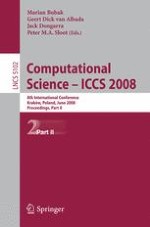The three-volume set LNCS 5101-5103 constitutes the refereed proceedings of the 8th International Conference on Computational Science, ICCS 2008, held in Krakow, Poland in June 2008. The 167 revised papers of the main conference track presented together with the abstracts of 7 keynote talks and the 100 revised papers from 14 workshops were carefully reviewed and selected for inclusion in the three volumes. The main conference track was divided into approximately 20 parallel sessions addressing topics such as e-science applications and systems, scheduling and load balancing, software services and tools, new hardware and its applications, computer networks, simulation of complex systems, image processing and visualization, optimization techniques, numerical linear algebra, and numerical algorithms. The second volume contains workshop papers related to various computational research areas, e.g.: computer graphics and geometric modeling, simulation of multiphysics multiscale systems, computational chemistry and its applications, computational finance and business intelligence, physical, biological and social networks, geocomputation, and teaching computational science. The third volume is mostly related to computer science topics such as bioinformatics' challenges to computer science, tools for program development and analysis in computational science, software engineering for large-scale computing, collaborative and cooperative environments, applications of workflows in computational science, as well as intelligent agents and evolvable systems.
